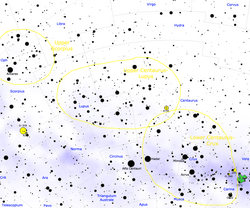Stellar association

Map of the area with the Scorpius–Centaurus Association.[1]
A stellar association is a loose star cluster, looser than both open clusters and globular clusters. Stellar associations usually have from 10 to 100 or more stars.
The stars have a common origin. They are moving together through space. Stellar associations were first discovered by the Soviet Armenian astronomer Victor Ambartsumian in 1947.[2][3]
Stellar Association Media
Main associations of the galactic plane in the night sky
References
- ↑ de Zeeuw, P.T.; Hoogerwerf, R.; de Bruijne, J.H.J.; Brown, A.G.A.; et al. (1999). "A Hipparcos Census of Nearby OB Associations". Astronomical Journal. 117 (1): 354–399. arXiv:astro-ph/9809227. Bibcode:1999AJ....117..354D. doi:10.1086/300682. S2CID 16098861.
- ↑ Lankford, John, ed. (2011) [1997]. "Ambartsumian, Viktor Amazaspovich (b. 1908)". History of Astronomy: An Encyclopedia. Routledge. p. 10. ISBN 9781136508349.
- ↑ Saxon, Wolfgang (15 August 1996). "Viktor A. Ambartsumyan, 87, Expert on Formation of Stars". The New York Times: 22. https://www.nytimes.com/1996/08/15/world/viktor-a-ambartsumyan-87-expert-on-formation-of-stars.html.

